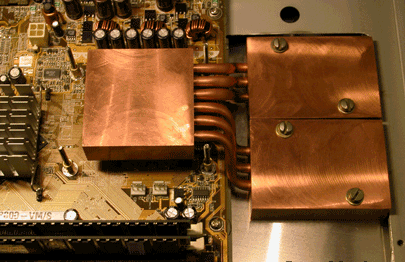I didn’t want to make the case for my fanless computer from scratch. The matter is that I’m lazy :). I’m joking. I just chose some other, more rational way from my point of view. This was my first experimental build, I wanted to try new techniques and verify their reliability and workability. Upgradeability was also a concern so I didn't want to approach the cooling problem as fundamentally as our guys did… at least until all potential problems are revealed. The fellows have already written everything about fanless technologies, so I’ll describe my device briefly.

The case's appearance turned out to be classic. At first I wanted to paint the heatsink but changed my mind later because it looked rather nice the way it was. The mod caused a problem: the case's center of gravity shifted to the heatsink side so I had to compensate this with a 2-kilogram piece of iron placed at the bottom. Otherwise the puter wasn't able to stand upright. The heat transfer system is made of three weighty copper ingots. The heat pipes used are shortened, Zalman type. Earlier one could buy longer pipes (an extra set for the TNN500), but no one sells them apart from the case anymore. But you can easily use ones taken out of a Tt Big Typhoon as described in this guide.

The heatsink is self-fabricated, I've described the process of its manufacturing in detail in a separate article abour homemade radiator. There are two such sinks in the case, they are screwed to a thick aluminium plate which serves heat distribution purposes. CPU heat blocks are screwed to that plate from the other side. I recommend you to use a dead mobo for modeling and estimation, I did so. Just don't forget that the CPU socket location on the working mobo is different (if it is).
The first problem I came across was the power unit. In my InWin case it sat very close to the mobo tray and got in the way.

I raised it a little with no trouble, having modded the back panel with a Dremel. A reminder for newbies: always disassemble the PC before dremeling, otherwise you have a good chance to short something out with metal chippings.

After PSU mounting alteration I cut out a rectangular opening in the back panel of the case. Heat blocks were installed through it. If you are planning to use long heat pipes I recomend you to space the blocks on the heatsink's base as widely apart as possible. Such disposition will favour more steady heat distribution. Before installing the blocks, you should fabricate a heatsink and mount it safely it in the case. The whole assembly looks the following way.


